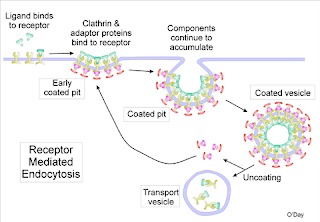 |
| Illustration of receptor–mediated endocytosis.3 Image Credit: Illustration courtesy of Professor Emeritus Danton H. O’Day, Department of Biology, University of Toronto Mississauga, Canada |
Topics: Biology, Cancer, Nanotechnology
Cancer is an inherently difficult illness to treat. Sometimes residual cancer cells remain even after removing tumors; sometimes parts of a tumor cannot be removed because of the way the cancer cells attach to a vital organ. A way to detect and kill cancer cells in vivo has been sought after for a long time, and some lines of research are finally showing great promise. The latest? Having cancer cells envelop dozens of nanoparticles that then are used to obliterate the cancer cell from the inside, leaving healthy cells untouched!1
The Gist of It
Essentially, nanoparticle therapy works by getting about a hundred gold nanoparticles clustered into a cancer cell, then blasting the area with an infrared laser pulse. Energy imparted by the laser causes the fluid around the cluster to reach temperatures high enough to vaporize the fluid, which causes a rapid expansion and collapse. This results in the obliteration of the cancer cell, but healthy cells are not affected because they don’t incorporate enough gold particles to cause damage. As the high temperatures remain confined within the nanobubble formed around the cluster, nearby cells are unharmed by the process.
How Do You Get Something Inside a Cell?
Cells can incorporate foreign objects in a number of ways, but the method that this research utilizes is called receptor-mediated endocytosis. In this process, the foreign object attaches itself to a point on the outside of the cell called a receptor, which is embedded in the cell’s outer membrane. Receptors have active ends on either side of the cell membrane, each of which attaches to certain molecules; the exterior side is selective for certain particles that the cell needs, while the interior end attaches to the proteins and signaling molecules that regulate cellular processes based on what’s happening outside the cell. The cell uses this method, for example, when it ingests a cholesterol molecule; the molecule binds to a receptor at the cell membrane, leading proteins to attach to the interior end of the receptor, thickening the cell membrane. A pit forms that then envelops the bound molecules into the cell.
Physics Central: Using Gold Nanoparticles to Kill Cancer,H. M. Doss
Comments